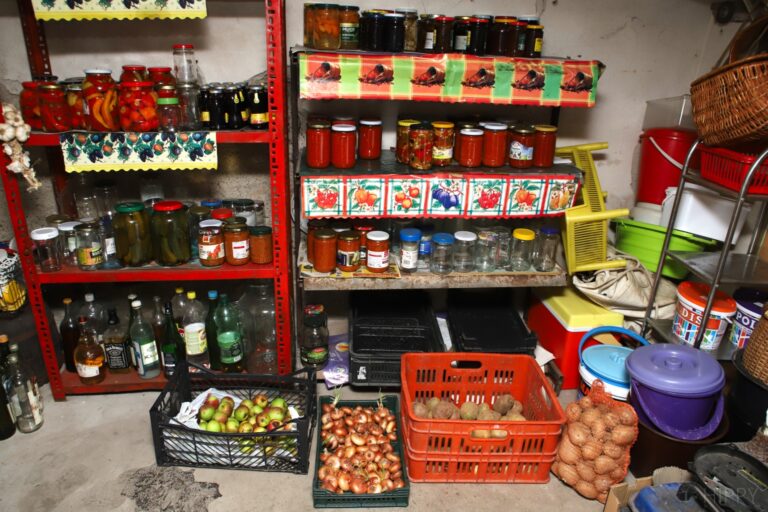How could should a root cellar be – and how can this simple building help you get more out of your garden’s harvest? We’ll explore just how beneficial it can be in this helpful guide.

We often take modern-day appliances, such as a refrigerator, for granted. We are confident that food will remain fresh in the refrigerator for some time.
Historically, though, this option was not available. The only alternative available was to use the properties that Mother Nature already provided.
Any container or room below ground can be used to create a root cellar. This can be used just like a refrigerator to store food.
How cold should a root cellar be to keep your produce fresh?
An efficient root cellar must be able to hold a stable temperature of 32º to 40ºF (0° to 4.5°C) year-round. This makes a root cellar as cold as a refrigerator.
To fully understand the benefits and natural cooling properties of a root cellar, we’ll explore the topic a bit more deeply.
How Does a Root Cellar Stay Cold?
How, then, is it possible that a root cellar can be kept this cold without using modern, electric-powered refrigeration devices? There must be more to it than just burying a room or a container in the ground, right?
Believe it or not, it’s really that simple!
Building a root cellar is easy provided that certain conditions are adhered to in its construction. This kind of storage facility uses the natural properties of the earth to cool.
In general, when we dig down into the earth, the temperature is reduced in comparison to the above-ground temperature.
There is only one foot of earth above a root cellar. This has been dug into the flat ground, where a temperature difference occurs. This small amount of earth will create a difference of approximately 20 degrees between the interior and outside temperature.
Consequently, if we can dig even further down, to approximately 10 feet to create a root cellar, it will maintain the temperature that we require to keep our food nice and cold.
The depth of 10 feet is not fixed, however, since you have to consider the location, soil type, and the ambient temperature above the ground.
Taking these factors into account, we can create a root cellar that is cool enough to store all the harvested crops that we need for the season ahead.
We are then able to enjoy our bounty whenever we want while also being assured that the cold of the root cellar has kept the food fresh, not frozen, and free of contaminants.
Why Do We Need to Store Food at Low Temperatures?
When we store food in the dark with the cool temperatures of a root cellar, we can slow the production of ethylene gas.
We are also able to greatly inhibit the growth of microorganisms.
It is the ethylene gas and the microorganisms that cause raw produce to ripen too quickly and then decompose.
Any raw produce that is kept in warm, well-lit environments will become inedible within a short period of time. If you’ve ever left fruits and vegetables out on your kitchen counter, you’ve probably witnessed this effect firsthand.
The cold temperatures in a root cellar do not stop the process of decomposition completely. However, the cold does slow it sufficiently so that the usable life can be extended quite considerably.
What Can We Store in a Chilled Root Cellar?
Numerous products can be stored in a root cellar to keep them in the best condition for as long as possible.
Not everything requires the same storage conditions. It is essential to do some research regarding adapting different techniques to use a root cellar.
Differing storage techniques and temperature zones are two benefits of the modern refrigerator – and you can mimic these benefits in your root cellar.
We’ll take a look at some items that can be stored in a root cellar and how long they may last when stored this way.
It is important to point out that conditions within individual root cellars will differ and this can affect how well (and how long) certain items will keep. You may find that you need to do some trial and error within your own root cellar.
How fresh a product is will also affect how long it will last in a root cellar. Something that has already started to decompose placed in the chilled environment of a root cellar will not store as well.
It will not last as long and as it breaks down, it could also affect the integrity and storage of other products in the store.
Different varieties of harvested crops, particularly late-harvested produce like winter squash, are better for storage in the chilled environment of a root cellar.
| Produce | Temperature | Average Storage Time |
|---|---|---|
| Potatoes | 40 to 45 ° F | 4 to 6 months |
| Sweet Potatoes | 55 to 60 ° F | 6 to 8 months |
| Tomatoes | No lower than 55 ° F | 1 to 6 months |
| Onions | Cool & Dry | 6 to 8 months |
| Pears | 29 to 31 ° F | 3 to 4 months |
| Broccoli | 32 ° F | 2 to 3 weeks |
| Citrus Fruits | cool | 6 to 8 weeks |
There are, of course, many other items that can benefit from the controlled temperature conditions you might be able to achieve in a root cellar.
Root cellars are perfect for storing not only home-produced items that have been dried, smoked, or canned but they are also perfect for store-bought products.
Homebrewed beers, wine, seeds, and even dormant, overwintering plants and bulbs are also good items that can be stored in the chilled conditions that can only be found in a root cellar.
Is a Root Cellar Able to Keep Food in Any Location?
A root cellar is constructed in such a way that the temperature inside should not fluctuate even if the temperature outside happens to change.
Different climatic regions in the United States have different outside temperatures. Consequently, different regions may require the way a root cellar is constructed to be adapted for them to reach and maintain the required chilled temperature.
Differing outdoor ambient temperatures and soil types will affect how deep a root cellar needs to be dug in order to access the natural chill zone.
While high temperatures create the correct environment for crops to rot, freezing temperatures will also render crops inedible. Therefore, these considerations are important to make even if you live in a climate that is naturally colder.
If we compare the regions of Alaska to Arizona, for example, the climate and soil type are completely different.
In Alaska, the temperature is below freezing for many months of the year. A root cellar is required to protect against the cold, not the heat, for these frigid months.
In Arizona on the other hand, heat is the enemy. A root cellar is suitable for most locations. However, as I’ve said, the depth and location of the storage area will be different according to the location.
How to Control a Cellar Temperature If It Is Not Stable
The temperature underground will vary according to the location’s distance from the equator. Extreme climatic areas that are either exceedingly hot or cold can prove to be a challenge for a root cellar to perform correctly without any extra assistance in heating or cooling.
The design of any root cellar should permit the control of humidity and temperature.
As we have said, the positioning, depth, and orientation of the cellar can help to either benefit from or eliminate the influence of the sun.
Anyone who builds a root cellar should install a thermometer and a hygrometer to check and monitor the temperature and humidity daily. Without adequate controls such as these, produce will not last as long as needed or desired.
A ventilation system is also key to controlling the temperature within the store. A fan-assisted system will allow cool air to be introduced and warm air to be expelled as required. It can prevent rot such as mildew and mold, too.
In warm climates, cooler nighttime temperatures can be vented into the root cellar by using such a fan system.
Think of this as opening a window in your house if it is warm inside and closing it when the temperature is cooler.
Even in Alaska, it is possible to control temperatures. You can use the sun to heat a ducting system that can introduce warm air into the root cellar via the ventilation system.
How Cold Is Cold?
A root cellar is a practically magical structure that uses the natural properties of the earth to maintain a stable temperature.
The perfect temperature for a root cellar is 32º to 40ºF (0° to 4.5°C).
It’s a big effort to dig a hole in the ground and expect it to maintain the ideal temperature without any assistance.
Therefore, you should design your root cellar so that the temperature and humidity can easily be monitored and controlled. This is especially important in locations that experience extreme climactic conditions.
When the right conditions are provided, though, this temperature will allow a range of fresh, preserved, or store-bought products to be protected from the natural decomposition process.
When these kinds of protections are put in place, you can expect your produce to last, in some cases, eight months or longer!
While a root cellar is a suitable method of storage for most parts of the United States, different climate zones, areas, and soil types may require alternative construction criteria in order to keep things fresh.
Do some research on what will be necessary to keep a root cellar productive and effective in your area – and then start digging!
This is one of the best food storage systems you can have in place – especially if you can keep it at the ideal temperature.

Three years ago, I bought an off-grid Cortijo in a small valley in the Andalucian mountains. Although, perhaps the lifestyle is in my genes as my grandfather and his four brothers were Homesteaders in Alberta Canada in the 1900s.
The mountains of Spain are a difficult place to grow many of the flowers that I was used to in the UK. However, veggies grow well year-round. Peppers, tomatoes, potatoes, lettuce, cucumber, melons, and chard all fare well in the Mediterranean climate. Almond trees provide me with a cash crop of around 1 ton while still retaining some to make almond milk and flour.
Meet the rest of the Homesteading Hippy team here.

Funny you do not mention another key componant to proper root cellar conditions and that is humidity. Without proper humidity for root crops temperature will not be the only factor. Just saying thanks
Hi Vic,
Yeah, the author focused on the temperature aspect, but you did give us a great idea for a new article to discuss this in depth. Thanks!
Dan